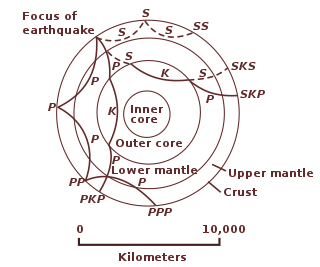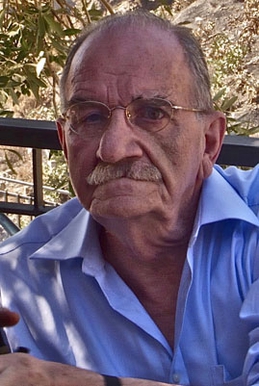Related Research Articles

Seismology is the scientific study of earthquakes and the propagation of elastic waves through the Earth or other planetary bodies. It also includes studies of earthquake environmental effects such as tsunamis as well as diverse seismic sources such as volcanic,tectonic,glacial,fluvial,oceanic,atmospheric,and artificial processes such as explosions. A related field that uses geology to infer information regarding past earthquakes is paleoseismology. A recording of Earth motion as a function of time is called a seismogram. A seismologist is a scientist who does research in seismology.

A seismic hazard is the probability that an earthquake will occur in a given geographic area,within a given window of time,and with ground motion intensity exceeding a given threshold. With a hazard thus estimated,risk can be assessed and included in such areas as building codes for standard buildings,designing larger buildings and infrastructure projects,land use planning and determining insurance rates. The seismic hazard studies also may generate two standard measures of anticipated ground motion,both confusingly abbreviated MCE;the simpler probabilistic Maximum Considered Earthquake,used in standard building codes,and the more detailed and deterministic Maximum Credible Earthquake incorporated in the design of larger buildings and civil infrastructure like dams or bridges. It is important to clarify which MCE is being discussed.

A seismometer is an instrument that responds to ground noises and shaking such as caused by quakes,volcanic eruptions,and explosions. They are usually combined with a timing device and a recording device to form a seismograph. The output of such a device—formerly recorded on paper or film,now recorded and processed digitally—is a seismogram. Such data is used to locate and characterize earthquakes,and to study the Earth's internal structure.
Peak ground acceleration (PGA) is equal to the maximum ground acceleration that occurred during earthquake shaking at a location. PGA is equal to the amplitude of the largest absolute acceleration recorded on an accelerogram at a site during a particular earthquake. Earthquake shaking generally occurs in all three directions. Therefore,PGA is often split into the horizontal and vertical components. Horizontal PGAs are generally larger than those in the vertical direction but this is not always true,especially close to large earthquakes. PGA is an important parameter for earthquake engineering,The design basis earthquake ground motion (DBEGM) is often defined in terms of PGA.
Induced seismicity is typically earthquakes and tremors that are caused by human activity that alters the stresses and strains on Earth's crust. Most induced seismicity is of a low magnitude. A few sites regularly have larger quakes,such as The Geysers geothermal plant in California which averaged two M4 events and 15 M3 events every year from 2004 to 2009. The Human-Induced Earthquake Database (HiQuake) documents all reported cases of induced seismicity proposed on scientific grounds and is the most complete compilation of its kind.
Earthquake engineering is an interdisciplinary branch of engineering that designs and analyzes structures,such as buildings and bridges,with earthquakes in mind. Its overall goal is to make such structures more resistant to earthquakes. An earthquake engineer aims to construct structures that will not be damaged in minor shaking and will avoid serious damage or collapse in a major earthquake. A properly engineered structure does not necessarily have to be extremely strong or expensive. It has to be properly designed to withstand the seismic effects while sustaining an acceptable level of damage.

Bruce Alan Bolt was an Australian-born American seismologist and a professor of earth and planetary science at the University of California,Berkeley. Professor Bolt was known as a pioneer of engineering seismology. He served for 15 years on the California Seismic Safety Commission leading public debate on earthquake safety in that state,and acted as a consultant on major projects throughout the world. As well,Bolt published a number of popular and technical books on seismology.
A cryoseism,ice quake or frost quake,is a seismic event caused by a sudden cracking action in frozen soil or rock saturated with water or ice,or by stresses generated at frozen lakes.
Susan Elizabeth Hough is a seismologist at the United States Geological Survey in Pasadena,California,and scientist in charge of the office. She has served as an editor and contributor for many journals and is a contributing editor to Geotimes Magazine. She is the author of five books,including Earthshaking Science (Princeton).
POLARIS (PUPS) was an underground experiment to observe seismic signals at depth in very hard rock. It was carried out at SNOLAB,and underground physics laboratory,in Sudbury,Ontario. In addition to academic research,the observational data collected by the POLARIS system was used by the Canadian National Data Centre (CNDC) for earthquake,and nuclear explosion monitoring. The name POLARIS is an acronym for Portable Observatories for Lithospheric Analysis and Research Investigating Seismicity.

Lucile M. Jones is a seismologist and public voice for earthquake science and earthquake safety in California. One of the foremost and trusted public authorities on earthquakes,Jones is viewed by many in Southern California as the "seismologist-next-door," who is frequently called up on to provide information on recent earthquakes.

ICEARRAY is an abbreviation for Icelandic Strong-motion Array. The ICEARRAY network is a seismic array of 14 strong-motion stations located within the South Iceland Seismic Zone. Each station consists of a seismograph situated in a protective housing. The stations are spread across a geographical area of approximately 3 km²in the town of Hveragerdi in south-western Iceland. Most of the units are located in the basements of residential buildings in Hveragerdi town centre,which is approximately 35 km southeast of Iceland's capital,Reykjavík. The ICEARRAY project is supported by the 6th Framework of the European Commission through the Marie Curie International Re-integration Grant,the Iceland Centre for Research and the University of Iceland Earthquake Engineering Research Centre.
Body-waves consist of P-waves that are the first to arrive,or S-waves,or reflections of either. Body-waves travel through rock directly.
The 2010 Central Canada earthquake occurred with a moment magnitude of 5.0 in Central Canada on 23 June at about 13:41:41 EDT and lasted about 30 seconds. The epicentre was situated in the area of Buckingham,Quebec,approximately 56 kilometres (35 mi) north of Ottawa,Ontario,closest to the settlement of Val-des-Bois,Quebec. Canada's capital,Ottawa,declared this earthquake as being its most powerful in 65 years.

The following outline is provided as an overview of and topical guide to geophysics:

Nicholas Neocles Ambraseys FICE FREng was a Greek engineering seismologist. He was emeritus professor of engineering seismology and senior research fellow at Imperial College London. For many years Ambraseys was considered the leading figure and an authority in earthquake engineering and seismology in Europe.
Sankar Kumar Nath is an Indian geophysicist,seismologist and a senior professor at the Indian Institute of Technology Kharagpur. He is known for his geotomographical studies and is an elected fellow of the Indian National Academy of Engineering,Indian Geophysical Union and the National Academy of Sciences,India,The Council of Scientific and Industrial Research,the apex agency of the Government of India for scientific research,awarded him the Shanti Swarup Bhatnagar Prize for Science and Technology,one of the highest Indian science awards for his contributions to Earth,Atmosphere,Ocean and Planetary Sciences in 2002.
Seismic intensity scales categorize the intensity or severity of ground shaking (quaking) at a given location,such as resulting from an earthquake. They are distinguished from seismic magnitude scales,which measure the magnitude or overall strength of an earthquake,which may,or perhaps may not,cause perceptible shaking.
With the development of both conventional and unconventional resources in Canada,induced seismicity caused by anthropological activities has been observed,documented,and studied.
References
- ↑ "Atkinson, Gail Marie, 1957-". Library of Congress. Retrieved February 25, 2022.
- 1 2 "Gail Atkinson" (PDF). The Canadian Geotechnical Society. Retrieved February 25, 2022.
- ↑ Heartfield, Kate (January 4, 2000). "The earthquake watch". The Ottawa Citizen. Retrieved February 26, 2022– via newspapers.com.
- ↑ Egan, Kelly (March 2, 2001). "A thumb on the Earth's pulse". The Ottawa Citizen. Retrieved February 26, 2022– via newspapers.com.
- ↑ "Quake: Early warnings vital to reducing catastrophe". The Ottawa Citizen. March 2, 2001. Retrieved February 26, 2022– via newspapers.com.
- ↑ Tam, Pauline (June 14, 2004). "Diagnosing the Earth's tremors". The Ottawa Citizen. Retrieved February 26, 2022– via newspapers.com.
- ↑ "Innovative Ontario scientists receive Premier's Research Excellence Awards". Ontario. April 23, 2003. Retrieved February 26, 2022.
- ↑ "Gail Atkinson: William B. Joyner Memorial Lectures 2007 Recipient". Seismological Society of America. Retrieved February 26, 2022.
- ↑ Winders, Jason (June 23, 2010). "Earthquake a case study for professors". Western News. University of Western Ontario. Retrieved February 26, 2022.
- ↑ "Induced Seismicity Research Program at Western University". Recorder. September 2014. Retrieved February 26, 2022.
- ↑ Winders, Jason (September 9, 2014). "Six researchers named to Royal Society of Canada". University of Western Ontario. Retrieved February 26, 2022.
- ↑ "Elements" (PDF). Canadian Geophysical Union. 2016. Retrieved February 26, 2022.
- ↑ Mayne, Paul (April 30, 2018). "Hellmuth Prize celebrates elite researchers". University of Western Ontario. Retrieved February 26, 2022.
- ↑ "Gail M. Atkinson". Seismological Society of America . Retrieved February 26, 2022.
- ↑ "Summer 2020: To Earth and Beyond" (PDF). University of Western Ontario. Summer 2020. Retrieved February 26, 2022.
- ↑ Winders, Jason (May 26, 2009). "FACULTY PROFILE: Predicting earth movements to make buildings safer". University of Western Ontario. Retrieved February 26, 2022.